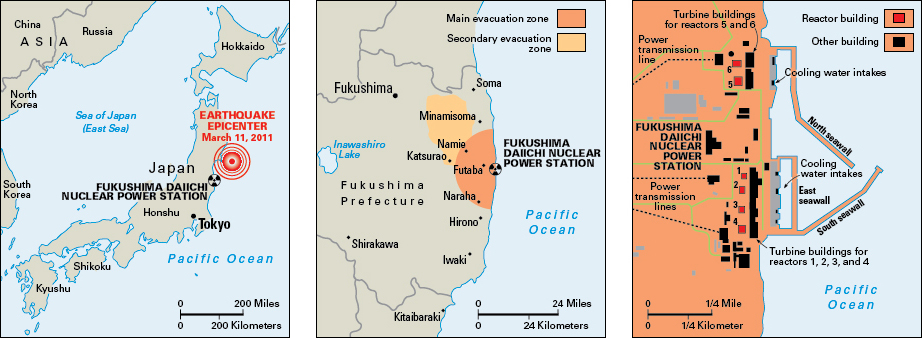Fukushima nuclear disaster was a major nuclear emergency in Japan in 2011. It was related to the severe earthquake and tsunami (series of powerful ocean waves ) that devastated the country on March 11 of that year (see Japan earthquake and tsunami of 2011 ). The tsunami damaged cooling systems at the Fukushima Daiichi Nuclear Power Station on the coast of Honshu, Japan’s largest island. As a result, nuclear fuel at the plant overheated, and radioactive material spread into the surrounding area. Problems related to the disaster persisted for years. 
The Fukushima Daiichi plant
lies on Honshu’s Pacific coast, in eastern Fukushima Prefecture. The Tokyo Electric Power Company (Tepco) began construction on the plant in 1967. The plant’s first nuclear reactor was commissioned in 1971. By 1979, six reactors were operating at the plant. Safety features included a sea wall designed to protect the plant from tsunami waves.
The disaster.
On March 11, 2011, at 2:46 p.m. local time, an earthquake of magnitude 9.1 struck off the coast of Honshu. Magnitude is a measurement of earthquake strength based on ground motion. The active reactors at the Fukushima Daiichi plant shut down automatically when the quake hit. The quake damaged electrical systems at the plant and disconnected it from outside power sources. On-site generators then began supplying power to the plant’s emergency cooling systems.
The earthquake displaced enormous volumes of water, causing the waves of the tsunami. The waves reached shore about 40 minutes after the earthquake, overwhelming the seawall and flooding the plant. Water engulfed most of the plant’s emergency generators, causing them to stop working. Nuclear fuel at the plant soon began to overheat.
Because the cooling systems were not functioning, hydrogen gas built up in the reactor buildings. Hydrogen gas is extremely flammable, and several hydrogen explosions shook the Fukushima Daiichi plant in the days following the earthquake. The explosions further damaged the plant buildings, exposing nuclear fuel to the atmosphere and releasing highly toxic radioactive material to surrounding areas. The government began evacuating some 80,000 people from a 12-mile (20-kilometer) radius around the plant. Later, it extended evacuations to some additional areas.
Technicians used both fresh water and seawater to cool the nuclear fuel. They also injected nitrogen into the reactor containment buildings to prevent further hydrogen explosions. Cleanup workers were allowed in the plant only for short periods each day to limit their exposure to dangerous radiation. By mid-July, the nuclear reactors had been stabilized.
Aftermath.
The Fukushima disaster raised serious questions about the safety of Japan’s nuclear power plants. In the aftermath of the disaster, all of Japan’s nuclear plants shut down for maintenance and safety inspections.
In July 2012, a government panel issued a report on the disaster at Fukushima. The report criticized Tepco for failing to address concerns about safeguards at the plant. In particular, the report found that Tepco officials had ignored engineers’ concerns that the sea wall was not sufficient to protect against a major tsunami. The report also criticized safety regulators for not implementing proper safety measures and for failing to adopt global nuclear safety standards. In addition, investigators found that plant operators had insufficient emergency plans in place.
In the years following the Fukushima disaster, Tepco struggled to keep radioactive material from leaking from the Fukushima plant. Officials estimated that it will take years, and possibly decades, to fully decontaminate the surrounding region and decommission the reactors.
In August 2023, as part of decommissioning the Fukushima plant, the Japanese government authorized the release of treated radioactive water from the plant into the Pacific Ocean. The water was treated with processes that remove nearly all radioactive materials from it. The release of the water was approved by the International Atomic Energy Agency (IAEA). But some countries objected to the release of the water, arguing that more studies needed to be done to confirm that the water was safe. China banned all imports of Japanese seafood in response to the release, and South Korea banned seafood from the fisheries around Fukushima Prefecture.
